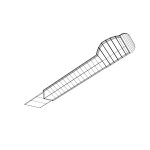“You can observe a lot just by watching”
Yogi Berra
 One of the foundational Lean tools is QCO (quick changeover), which is also sometimes referred to as SMED (single minute exchange of die). SMED includes a set of techniques that make it possible to perform equipment set-up and changeover operations in less than 10 minutes. Not every changeover can be completed in this amount of time. However, any operation would benefit from using this Lean tool if there is a requirement for:
One of the foundational Lean tools is QCO (quick changeover), which is also sometimes referred to as SMED (single minute exchange of die). SMED includes a set of techniques that make it possible to perform equipment set-up and changeover operations in less than 10 minutes. Not every changeover can be completed in this amount of time. However, any operation would benefit from using this Lean tool if there is a requirement for:
- a change in “lot” types
- a process or set-up change
For this discussion, I will use the term QCO as being interchangeable with SMED. Most of the time, the opportunity for implementing QCO in a process is driven by the need for greater flexibility, quicker delivery, better quality, or higher productivity. These are indeed significant benefits that are realized – because this approach identifies and removes some of the eight sources of waste. But there is an equally significant benefit to assessing a process and implementing QCO: the resulting process changes often make setups simpler & easier – and therefore faster and safer. The following case studies demonstrate how using QCO principles can lead to work which is not only completed in less time, but is also safer.
Case One: “The Frustrating Fabric”
Every six to eight weeks at a large manufacturing facility, a major equipment changeover takes place. While the machine is down for maintenance, a crew of eight persons is assembled to remove a large, heavy, wet, worn piece of fabric. Removing the old fabric is a fairly straightforward task. Because the old fabric can be cut, it can be removed in sections without much difficulty. However, the new replacement fabric that needs to be installed in the same position has an ‘endless’ design that cannot be cut. There are many tight locations and constricted areas. The crew is forced to stand and pull in awkward positions to get the task completed. The entire procedure can take as long as two hours (longer if things do not go well). The process owner wanted to find a better way to get this job done. He sponsored a team that used QCO thinking to determine improvements. After the team mapped and filmed the process, they identified and  implemented numerous changes that allowed for a faster installation. These included:
implemented numerous changes that allowed for a faster installation. These included:
- Installing a new winch
- Adding pulleys
- Developing a new slide
- Modifying the bolt types
As a result, the new fabric can be installed in about half the time. With these changes, the work was now faster and safer for the crew. This translated to a significantly lower risk for injuries like strains, cuts, or contusions. One crew member shared that, “I wonder why we didn’t make these changes earlier. This is still a tough job. But now it is less frustrating…”
Case Two : “The Rapid Razor”
Another QCO opportunity was identified with the objective of reducing the time to changeover between rolls of paper on a small processing unit. As part of this process, a person is required to splice together two webs of paper. The operator has to prepare the splice by making a specific cut across the paper web, then use a special tape to join the paper together. This procedure is done several times during a shift. When the team first observed this task, it looked simple.  With assistance from the operator, team filmed this splicing operation. Later, when they reviewed the video, there was an audible gasp in the room. When running the film in slow motion, they saw that the experienced operator was performing a cutting motion so quickly that no one had observed “live” what there was now on film. Two times he rapidly passed the razor blade within an inch of his hand! When the team showed him the video and asked him about this, his response was that “I never realized that I was bringing the knife that close to my other hand. I’ve done this job for years and it’s just a habit that I developed. I have only nicked myself a few times.” Working with the crews, the team devised some simple changes to the procedure that not only saved a few minutes of time on each change, but also reduced the likelihood that the operator would risk getting cut. In addition, the operators were provided with a much safer cutting tool than the retractable blade version that was previously used. The result was a faster and safer work method.
With assistance from the operator, team filmed this splicing operation. Later, when they reviewed the video, there was an audible gasp in the room. When running the film in slow motion, they saw that the experienced operator was performing a cutting motion so quickly that no one had observed “live” what there was now on film. Two times he rapidly passed the razor blade within an inch of his hand! When the team showed him the video and asked him about this, his response was that “I never realized that I was bringing the knife that close to my other hand. I’ve done this job for years and it’s just a habit that I developed. I have only nicked myself a few times.” Working with the crews, the team devised some simple changes to the procedure that not only saved a few minutes of time on each change, but also reduced the likelihood that the operator would risk getting cut. In addition, the operators were provided with a much safer cutting tool than the retractable blade version that was previously used. The result was a faster and safer work method.
Case Three: “The Bad Back Bolts”
Sometimes a little support can make all the difference. When a team was charged with reducing the set-up time for an industrial chipper, their original goal was to gain an additional 15 minutes with each 100-minute changeover. The process was studied in detail. Some internal tasks were changed to external tasks. An additional 5S effort reduced the time that was wasted while looking for tools. As a result, the total changeover time was reduced by 18 minutes. However, the observation that caught every person’s attention was the process that was used by the operator to remove (and later torque) over 50 bolts. In order to reach some of the bolts with a heavy air wrench, at times he was reaching over his head. Other times he was bent over at the waist. Even a novice could see that his body positioning was a prime factor for potential back strains, which some operators had reported over the years. ![]()
 The solution? Someone retrieved a portable adjustable-height stool from an office area. The operator remained in a seated position with the air wrench at chest level. He was now in a more ergonomic position for this repetitive task. The chipper was then rotated to bring the bolts into a position, where they could easily be reached. The new procedure was faster and safer. The operator commented afterwards that “This job doesn’t seem quite as tiring …”
The solution? Someone retrieved a portable adjustable-height stool from an office area. The operator remained in a seated position with the air wrench at chest level. He was now in a more ergonomic position for this repetitive task. The chipper was then rotated to bring the bolts into a position, where they could easily be reached. The new procedure was faster and safer. The operator commented afterwards that “This job doesn’t seem quite as tiring …”
Pull, Tool, Stool
Three simple changes:
- An easier way to pull a heavy object
- A better tool to use for the job
- A stool for good ergonomics
Three improvements made a difference in reducing the risk of injury. In each case, small changes made it easier, faster, and safer to do the job. And what was the investment? The intellect of a small team and the people who actually do the work.
Rushing vs Efficiency
I want to make a clarification on this topic. Some people confuse working faster with working more efficiently. It is important to note that there is a distinction between rushing to get a job done and making the job easier to get a job done.
- If someone feels rushed, they are more likely to take shortcuts and place themselves at risk. In these cases, no one has performed an assessment on how the work is done. The person is simply expected (often by the supervisor) to just do the current job faster. Although the operator may be able to complete the job more quickly, it is only because he is forced to pick up his pace in an inefficient process. But this speed comes with a price – risk. Indeed, the “rush factor” is a state of mind that has been proven to contribute to errors and increase risk.
- If someone is performing a task where the job has been re-designed to make it easier, the work is more planned and methodical. As a result, the job can be completed more quickly, as well as with less risk. The person is attentive to the task at hand. He is less likely to be fatigued or frustrated with how the work is getting done. He is faster because he is more efficient – there is less waste in the process.
Summary
QCO is a Lean tool that is used to focus on reducing the time it takes for equipment set-ups or changeovers. It has huge potential benefits in quicker delivery, higher quality, and increased productivity, among others. These principles also result in improved work processes that are simpler & easier – and therefore faster and safer. This aligns with the notion that people will perform a task in a certain way if they have the ability to complete the task (if we make it easier to do). If we simply demand that people work faster without providing an opportunity to lean the process, we introduce the “rush factor” into their work. This significantly increases their risk profile. On the other hand, if we are diligent in re-designing the work using QCO principles and removing waste, we gain productivity while decreasing risk.
References
Quick Changeover for Operators: The SMED System. (Based on A Revolution in Manufacturing: The SMED System by Shigeo Shingo). Productivity Press. 1996. ISBN 978-1-56327-125-0.
Inside Out – Rethinking Traditional Safety Management Paradigms. Larry Wilson and Gary Higbee. Ecolab Limited. 2012. ISBN 978-0-9881577-0-5.
Photo by ralphbijker on Flickr. http://creativecommons.org/licenses/by/2.0/


[…] or changeovers. This results in a loss of productive capacity, all other things being equal. A previous post provided some examples of QCO that resulted in reduced set-up time, while creating … This technique is a cornerstone of lean […]